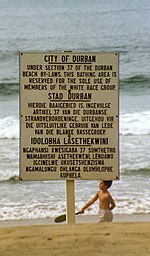| uMkhonto weSizwe | |
|---|---|
 | |
| Founder | Nelson Mandela |
| Leaders | |
| Dates of operation | 1961–1993 |
| Merged into | |
| Allegiance | |
| Allies | SWAPO (Until 1990) |
| Opponents | |
| Battles and wars | Angolan Civil War South African Border War Rhodesian Bush War Internal resistance to apartheid |
| Designated as a terrorist group by | |
| Part of a series on |
| Apartheid |
|---|
 |
uMkhonto weSizwe (Xhosa pronunciation: [um̩ˈkʰonto we ˈsizwe]; abbreviated MK; English: Spear of the Nation) was the paramilitary wing of the African National Congress (ANC), founded by Nelson Mandela in the wake of the Sharpeville massacre. Its mission was to fight against the South African government to bring an end to its racist policies.[1]
After warning the South African government in June 1961 of its intent to increase resistance if the government did not take steps toward constitutional reform and increase political rights, uMkhonto weSizwe launched its first attacks against government installations on 16 December 1961. The group was subsequently classified as a terrorist organisation by the South African government, and banned.[2]
For a time it was headquartered in Rivonia, which was rural at that time but is now an affluent suburb of Johannesburg. On 11 July 1963, nineteen ANC and uMkhonto weSizwe leaders, including Arthur Goldreich, Govan Mbeki and Walter Sisulu, were arrested at Liliesleaf Farm, Rivonia. (The farm was privately owned by Arthur Goldreich and bought with South African Communist Party and ANC funds, as non-whites were unable to own a property in that area under the Group Areas Act.) The arrests were followed by the Rivonia Trial, in which ten leaders of the ANC were tried for 221 militant acts that the prosecution said were designed to "foment violent revolution". Wilton Mkwayi, chief of uMkhonto weSizwe at the time, escaped during the trial.
The organisation was formally disbanded in a ceremony at Orlando Stadium in Soweto, Gauteng, on 16 December 1993, although its armed struggle had been suspended earlier, during the negotiations to end apartheid.[3]
- ^ "Manifesto of Umkhonto we Sizwe". African National Congress. 16 December 1961. Archived from the original on 17 December 2006. Retrieved 30 December 2006.
- ^ "The African National Congress website – Umkhonto we Sizwe". Archived from the original on 20 February 2015. Retrieved 21 January 2015.
- ^ Lissoni, Arianna (22 December 2021). "Umkhonto we Sizwe (MK): The ANC's Armed Wing, 1961–1993". Oxford Research Encyclopedia of African History. doi:10.1093/acrefore/9780190277734.013.1098. ISBN 978-0-19-027773-4. Retrieved 16 November 2022.